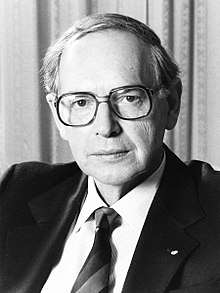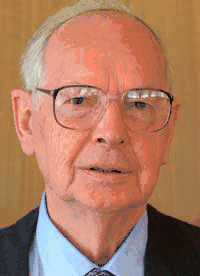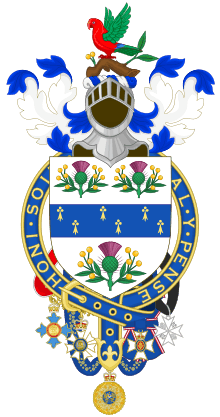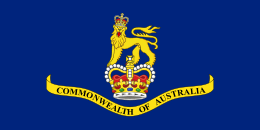Ninian Stephen
Sir Ninian Martin Stephen KG AK GCMG GCVO KBE QC (15 June 1923 – 29 October 2017) was an Australian judge who served as the 20th Governor-General of Australia, in office from 1982 to 1989. He was previously a Justice of the High Court of Australia from 1972 to 1982.[1]
Sir Ninian Stephen KG AK GCMG GCVO KBE QC | |
|---|---|
 | |
| 20th Governor-General of Australia | |
| In office 29 July 1982 – 16 February 1989 | |
| Monarch | Elizabeth II |
| Prime Minister | Malcolm Fraser Bob Hawke |
| Preceded by | Sir Zelman Cowen |
| Succeeded by | Bill Hayden |
| Justice of the High Court of Australia | |
| In office 1 March 1972 – 11 May 1982 | |
| Nominated by | Billy McMahon |
| Appointed by | Sir Paul Hasluck |
| Preceded by | Sir Victor Windeyer |
| Succeeded by | Sir William Deane |
| Judge of the Supreme Court of Victoria | |
| In office 30 June 1970 – 29 February 1972 | |
| Nominated by | Sir Henry Bolte |
| Appointed by | Sir Rohan Delacombe |
| Preceded by | Robert Monahan |
| Succeeded by | William Kaye |
| Personal details | |
| Born | Ninian Martin Stephen 15 June 1923 Nettlebed, Oxfordshire, England |
| Died | 29 October 2017 (aged 94) Melbourne, Victoria, Australia |
| Spouse(s) | Valerie Sinclair ( m. 1949) |
| Children | 5 |
| Profession | Barrister, judge |
| Military service | |
| Allegiance | Australia |
| Branch/service | Second Australian Imperial Force |
| Years of service | 1941–1946 |
| Rank | Lieutenant |
| Unit | Royal Australian Artillery Royal Australian Engineers |
| Battles/wars | Second World War |
Stephen was born in England to Scottish parents. As a child he lived for periods in France, Germany, Scotland, and Switzerland, eventually arriving in Australia at the age of 16. Stephen served with the Australian Army during World War II, and after the war entered the legal profession. He became one of Australia's leading constitutional lawyers. Stephen was appointed to the Supreme Court of Victoria in 1970, and then to the High Court in 1972, aged 48. He was considered a member of the court's "moderate centre". In 1982, Stephen was appointed governor-general on the recommendation of Malcolm Fraser. He approved two double dissolutions during his time in office, the only governor-general to do so. After his term expired, Stephen remained active in public life as a conservationist and member of various international tribunals. He died at the age of 94, making him Australia's longest-lived governor-general.
Early life
Stephen was born in Nettlebed, Oxfordshire, England, to Scottish parents, Barbara (née Cruickshank) and Frederick Brown Stephen. His father, a poultry farmer and ex-soldier, deserted the family shortly after his birth, moving to Canada and starting a new family; his son was told that he had died, and did not learn the truth until 2003. Stephen's mother was a paid companion for Nina Mylne, the wealthy heiress of the Queensland pastoralist Graham Mylne; his given name was in her honour. During his early childhood, the three of them lived for periods in Switzerland (Geneva, where he was christened), France (Paris, Cannes, and Saint-Cast-le-Guildo) and Germany (Wiesbaden). They eventually moved to Edinburgh in 1929 so Stephen could begin his formal schooling.[2]
Mylne paid for Stephen's education, which took place in Scotland (George Watson's College and Edinburgh Academy), London (St Paul's School), and Switzerland (Chillon College, Montreux). He and Mylne generally travelled together, while his mother remained in Scotland and ran a boardinghouse. In 1940, the three of them moved to Australia to avoid the war. They settled in Melbourne and Stephen attended Scotch College for two terms, and was then accepted into the University of Melbourne to study law.[2][3]
Second World War
In December 1941, following the end of his first year at university, Stephen enlisted in the Citizens Military Force to serve part-time in the Melbourne University Regiment. Following Japan's entry into the Second World War, Stephen completed full-time military training from 8 December 1941 to 15 February 1942 and was then posted to the 10th Field Regiment, Royal Australian Artillery, serving in Western Australia. He subsequently transferred to the Second Australian Imperial Force. In late 1943, Stephen transferred to the Royal Australian Engineers, serving in New Guinea from April to August 1944 with the 43rd Australian Water Transport Company. He then attended courses, culminating in a commissioning course in April 1945. As a lieutenant, he served in the 41st Australian Landing Craft Company in New Guinea and New Britain. In August 1945, he was posted to Labuan, Borneo, arriving after the war's end and serving there until January 1946. After returning to Australia, he was discharged on 5 February 1946.[4]
Legal career
Stephen completed his studies after the war's end, and was admitted to the Victorian Bar in 1949. By the 1960s, he had become one of Australia's leading constitutional and commercial lawyers. He was made a Queen's Counsel in 1966.[1]
Judicial career
On 30 June 1970, Stephen was appointed as a judge of the Supreme Court of Victoria. He held this position until 29 February 1972, relinquishing it to take up his appointment as a Justice of the High Court of Australia.[1] Sworn of the Privy Council of the United Kingdom in 1979 and sat as a member of its Judicial Committee[5].
Although Stephen was appointed to the High Court by a Liberal government, he proved not to be a traditional conservative upholder of states' rights. He joined the "moderate centre" of the court, between the arch-conservatism of Sir Garfield Barwick and the radicalism of Lionel Murphy. In 1982 he was part of the majority that decided on a broad interpretation of the "external affairs power" of the Australian constitution in the Koowarta v Bjelke-Petersen case.[6]
Governor-General
In March 1982, Prime Minister Malcolm Fraser announced that Stephen would succeed Sir Zelman Cowen as Governor-General of Australia.[1] His appointment was praised by both sides of politics.[7] He was sworn in on 29 July 1982, the first former High Court judge to become governor-general since Sir Isaac Isaacs in 1931. When Fraser was defeated by the Labor Party under Bob Hawke in 1983, Stephen had no difficulty working with a Labor government. In 1987, his term was extended by 18 months as a mark of personal respect and also to allow Bill Hayden (to whom Hawke had promised the position) to leave politics at a time of his choosing. Stephen is the only governor-general to have approved two double dissolutions – in 1983 (for Fraser) and 1987 (for Hawke).[8]
Later work

In 1989, Stephen became Australia's first Ambassador for the Environment[1] and, in his three-year term, was particularly energetic in working for a ban of mining in Antarctica. In 1991 he undertook a difficult task when he was appointed chairman of the second strand of the Northern Ireland peace talks. From 1991 to 1995, he was a judge ad hoc of the International Court of Justice in the case East Timor (Portugal v. Australia) 1991–1995.[9] From 1993 to 1997, he was a judge on the international tribunals investigating war crimes in Yugoslavia and Rwanda. He also served as chairman of the Australian Citizenship Council from 1998.[10] In 1994, he acted as a special envoy of the UN Secretary General to resolve political conflicts in Bangladesh.[7]
Stephen later moved back into the legal field, becoming president of an arbitral tribunal constituted under Chapter 11 of the North American Free Trade Agreement (NAFTA), charged with the adjudication of an investment dispute between Mondev, a Canadian investor, and the United States.[11]
A detailed scholarly biography of Stephen, Fortunate Voyager by Philip Ayres, was released in September 2013.[12] Drawing upon it, Ayres also summarised Stephen's career for the Victorian Bar News.[13]
Titles, styles and honours
| Viceregal styles of Sir Ninian Stephen | |
|---|---|
| Reference style | His Excellency |
| Spoken style | Your Excellency |
Stephen was made a Knight Commander of the Order of the British Empire (KBE) on 20 April 1972 "for distinguished services to the Law",[14] and sworn of the Privy Council in 1979. As governor-general he was made a Knight of the Order of Australia (AK), Knight Grand Cross of the Order of St Michael and St George (GCMG) and Knight Grand Cross of the Royal Victorian Order (GCVO). In 1994 Queen Elizabeth II appointed him a Knight of the Order of the Garter (KG), being the most recent Australian to be granted a knighthood in the personal gift of the monarch of Australia. He therefore had the unusual distinction of holding five separate knighthoods and joined Lord Casey and Sir Paul Hasluck as one of the few Australian Knights of the Order of the Garter. In 1983 he was named a Commandeur of the French Légion d'honneur.[15][16][17]
Stephen delivered the first Sir Ninian Stephen Lecture at the University of Newcastle's law school in 1993, giving his name to this lecture series.[18]
| Knight of the Order of the Garter (KG) | 1994[19] | |
| Knight of the Order of Australia (AK) | 1982[20] | |
| Knight Grand Cross of the Order of St Michael and St George (GCMG) | 1982[21] | |
| Knight Grand Cross of the Royal Victorian Order (GCVO) | 1982[22] | |
| Knight Commander of the Order of the British Empire (KBE) | 1972[23] | |
| Knight of Grace of the Venerable Order of St John of Jerusalem (KStJ) | 1982[24] | |
| 1939–45 Star | [24] | |
| Pacific Star | [24] | |
| War Medal 1939–1945 | [24] | |
| Australia Service Medal 1939–45 | [24] | |
| Queen Elizabeth II Silver Jubilee Medal | 1977[24] | |
| Centenary Medal | 2001[25] | |
| Commandeur of the Legion of Honour | France; 1983 |
Personal life and death
In June 1949, Stephen married Valerie Sinclair (born 3 July 1925)[26] and they had five daughters.[27] One of his children, Mary, was married to Peter Hayes.[28] Stephen and his wife were patrons of the Australian Inland Botanic Gardens.[29] He died in Melbourne on 29 October 2017, aged 94.[7][30][31] A state funeral for Stephen was held on 8 November at St Paul's Cathedral, Melbourne.[32][33][34]
Arms
 |
|
References
- High Court of Australia (2010). "About the Justices". Retrieved 7 May 2011.
- Ayres, Philip (2013). Fortunate Voyager: The Worlds of Ninian Stephen. Melbourne University Publishing. ISBN 9780522862089.
- Carroll, Brian (2004). Australia's Governors-General: From Hopetoun to Jeffery. Rosenberg. pp. 173–179. ISBN 1877058211.
- Service Record, VX107617 Stephen, Ninian Martin, B883, VX107617, National Archives of Australia, https://recordsearch.naa.gov.au/SearchNRetrieve/Interface/DetailsReports/ItemDetail.aspx?Barcode=6090879&isAv=N
- https://research.qut.edu.au/ https://research.qut.edu.au/tnep/team/the-rt-hon-sir-ninian-stephen/. Retrieved 6 May 2020. Missing or empty
|title=(help); External link in|website=(help) - Fricke, Graham (1986). Judges of the High Court. Melbourne: Century Hutchison. ISBN 0-09-157150-2.
- "Sir Ninian Stephen, former governor-general, dies, aged 94". Sydney Morning Herald. 29 October 2017. Retrieved 29 October 2017.
- Carroll, Brian (2004). Australia's Governors-General: From Hopetoun to Jeffery. Rosenberg. ISBN 1877058211.
- East Timor (Portugal v. Australia), Judgment, I.C.J. Reports 1995, p. 90.
- "Sir Ninian Stephen". Education Services Australia. Retrieved 29 October 2017.
- Mondev International Ltd. v. United States of America, ICSID Case No. ARB(AF)/99/2
- Ayres, Philip (2013). Fortunate Voyager: The Worlds of Ninian Stephen. Carlton: Megunyah/Melbourne University Publishing. ISBN 9780522862089.
- Ayres, Philip (Winter 2014). "Ninian Stephens at the Victorian Bar". Victorian Bar News. The Victorian Bar Inc. pp. 30–34. Archived from the original on 6 December 2014. Retrieved 5 December 2014.
- "No. 45652". The London Gazette. 21 April 1972. p. 4777.
- Philip Ayres. Fortunate Voyager: The Worlds of Ninian Stephen. Retrieved 19 July 2014
- ABC Editorial Policies: About the Authors, p. 5. Retrieved 19 July 2014
- Academy of the Social Sciences in Australia, Dialogue 22, 2/2003, p. 11 Archived 4 March 2014 at the Wayback Machine. Retrieved 19 July 2014
- "The Sir Ninian Stephen Lecture 2014". University of Newcastle Australia. 5 September 2014. Retrieved 29 October 2017.
- "No. 53654". The London Gazette. 26 April 1994. p. 6173.
- "STEPHEN, Ninian Martin – Knight of the Order of Australia". It's an Honour database. Australian Government. 29 July 1982. Retrieved 1 April 2018.
- "No. 49120". The London Gazette. 24 September 1982. p. 12413.
- "No. 49255". The London Gazette. 4 February 1983. p. 1697.
- "No. 45652". The London Gazette. 21 April 1972. p. 4777.
- Smith, Heide (1988). "Sir Ninian Stephen – Governor General of Australia – 1988". Portraits of Australians. Archived from the original on 20 April 2013. Retrieved 1 February 2012.
- "STEPHEN, Ninian Martin – Centenary Medal". It's an Honour database. Australian Government. 1 January 2001. Retrieved 1 April 2018.
- https://m.facebook.com/internationalhousemelbourne/photos/a.131896676855110.12001.131890836855694/1018523464859089
- https://www.thetimes.co.uk/article/sir-ninian-stephen-obituary-2lgl02b70
- Fox, K (17 February 2015). "Australian Legal Dynasties: The Stephens and the Streets". Australian Dictionary of Biography.
- "A community project". wentworth.nsw.gov.au. Archived from the original on 11 July 2009. Retrieved 2 October 2009.
- "Former governor general Sir Ninian Stephen dies aged 94". The Guardian. 29 October 2017. Retrieved 29 October 2017.
- Bevege, Alison (29 October 2017). "Australian former governor-general and peacemaker Ninian Stephen dies at 94". Reuters. Retrieved 30 October 2017.
- http://mobile.abc.net.au/news/2017-11-08/former-governor-general-ninian-stephen-funeral/9129062
- https://thewest.com.au/politics/state-funeral-for-sir-ninian-stephen-ng-s-1794870
- http://www.smh.com.au/national/former-governorgeneral-sir-ninian-stephen-remembered-as-a-great-australian-20171108-gzh601.html
- Banner of arms image Archived 31 December 2013 at the Wayback Machine, College of St George website. Retrieved 27 December 2013.
- Banner of arms image. Arms shown over the crest (A parrot), a blue fess, tincture according to the torse. College of St George website. Retrieved 27 December 2013.
- Crest image, Heraldic Sculptor. Retrieved 27 December 2013.
- Order of Australia insignia. The Order of Australia Association. Retrieved 27 December 2013.
External links
| Wikimedia Commons has media related to Ninian Stephen. |
- Supreme Court of Victoria Website
- The Bob Hawke Prime Ministerial Centre website
- Obituary by Geoffrey Robertson, The Guardian
- Australian Senate condolences: "Senate Hansard". Parliament of Australia. 13 November 2017. pp. 45–53. Retrieved 23 November 2017.
| Government offices | ||
|---|---|---|
| Preceded by Sir Zelman Cowen |
Governor-General of Australia 1982–1989 |
Succeeded by Bill Hayden |
| Diplomatic posts | ||
| New title | Australian Ambassador for the Environment 1989–1992 |
Succeeded by Penelope Wensley |

